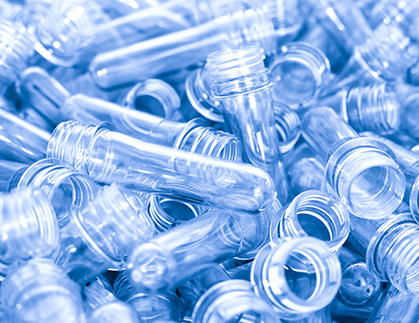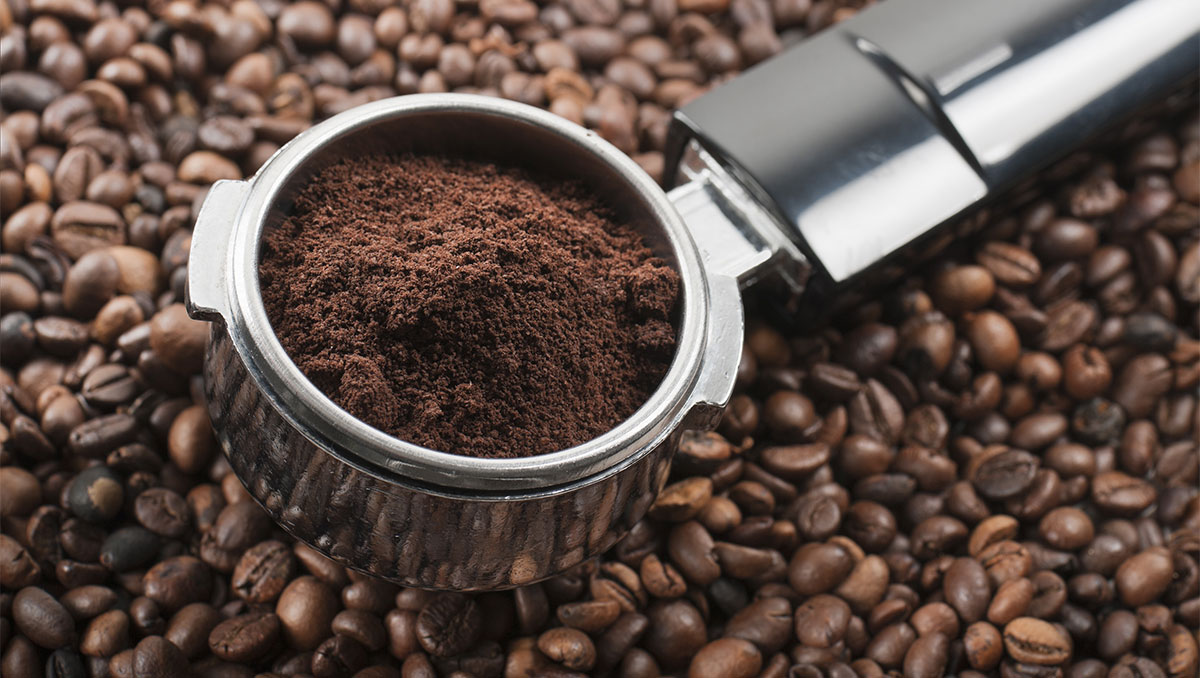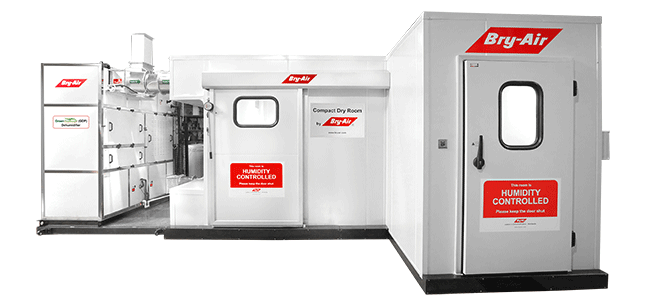Adverse Effects of Humidity and the Most Effective Ways to Control it
Majority of the pharmaceutical products are highly hygroscopic and tend to suffer physical, enzymatic, microbiological and biochemical deterioration after coming in contact with moisture. Even the simplest form of pharmaceutical manufacturing process can involve a range of steps before the finished product is packaged and finally reaches the consumer. These may include:
- Lab-scale development using glove boxes, small-scale process driers and coaters, and fluid bed driers
- Micronizing
- Storage of powders or liquids
- Mixing
- Product drying
- Tablet compression
- Film coating
- Sugar coating
- Aseptic packaging
- Blister packaging
- Storage of the finished product, etc.
Throughout these processes, the effects of ambient humidity can have detrimental effects on product quality, yield, visual appearance and shelf-life, issues that can effectively be avoided by the careful control of humidity in the production spaces.
Furthermore, R&D studies may have determined that a certain product either cannot successfully be manufactured, or may have significantly reduced yield at differing humidity.
Humidity/moisture is a constant threat to production efficiency and product quality. Moisture causes problems like disintegration of tablets, decomposition of formulations, lumping, caking and agglomeration of chemical compounds, uneven coating on tablets, inability to compress tablets, retarded growth in organic cultures and a shorter shelf life to name just a few.
Humidity control or Dehumidification, thus, becomes almost essential in processing, manufacturing, storage, research and testing areas in the Pharmaceutical Industry.
Need For Quality Compressed Air
Compressed air, commonly called Industry’s fourth utility, is commonly used in the pharma industry for automatic packaging machinery for sealing, Blister Pack Machine, Powder Filling Machine, Tablet Press Machine, Capsule Filling Machine, Drying Container, Vacuum cleaning system . The production facilities of the different segments within the Pharma industry have different applications for compressed air.
Untreated compressed air contains many potentially harmful or dangerous contaminants which must be removed or reduced to acceptable levels in order to protect the consumer and provide a safe and cost-effective production facility. Presence of moisture in the compressed air line is a potential hazard and must be removed.
Effects of High Humidity and Its Control
Many pharma products cannot physically be produced without careful control of ambient humidity, as significant degradation of the product can occur above certain levels. Enzyme-based diagnostics, for example, are very susceptible to changes in humidity and to levels of relative humidity higher than 10%.These control requirements are also affected by changes in the seasons, with summer conditions generally being worse than those in the winter (as far as airborne moisture is concerned). In a perfect world, summer conditions would be able to be controlled at winter levels, so that production rates remained constant throughout the year leading to more reliable production.
Humidity in processing, manufacturing, testing, packaging and storage areas can be devastating for the pharmaceutical products and can cause.
- Hygroscopic material which most pharma products are to deteriorate
- Moisture regain
- Organic Corrosion
- Biochemical reactions
- Activates injurious activity of micro-organism
- Impairs product accuracy and uniformity in formulations
Deteriorated Characteristics of Hygroscopic Materials
All hygroscopic materials will absorb or desorb moisture from the atmosphere until they reach their equilibrium moisture content.
Hygroscopic material will take up or dispel moisture in relation to the relative humidity of the air mixture to which it is exposed, when in equilibrium with air at 100% RH it is hygroscopically saturated.
The higher the Relative Humidity in the surrounding air, the higher will be the moisture regain. e.g. For gelatin at 10% RH the moisture content by percentage of dry weight is 0.79% but at 90% RH the moisture content is 11.4% of dry weight. Certain materials require extremely low or high moisture contents during manufacture and storage.
Injurious Activities of Micro Organisms
An excessive moisture content can indirectly contribute to the destruction of organic material by increased microbial activity.
Mould, mildew and fungi are all different types of bacteria. Outdoor air is well endowed with this bacteria which are small enough to be carried indoors and which will settle on materials. The spores lie dormant until suitable conditions of temperature and humidity are achieved. In general, the spores will not germinate below 60% RH.
The actual temperature conditions for germination may vary widely between different types of moulds.
Once germinated, the mold prospers, and the speed of growth is a function of temperature and humidity. The condensed moisture on materials acts as a medium conducive to the growth of bacteria. Moreover, at high temperature the activity of the micro organisms increases but a certain amount of activity occurs even at very low temperatures.
This microorganism growth is injurious to materials; as it not only results in decomposition but also mechanical weakening of the products. In most cases, bacterial growth can be arrested if RH is maintained below 45%.
Air Humidity and Damage Caused by Too High Humidity
A certain amount of water vapour is always present in the air. The water vapour or moisture is measured in terms of relative humidity.
The outdoor relative humidity has a direct bearing on the indoor humidity environment. The problem is compounded and distributed as a result of infiltration through ceilings, walls and floors. In addition to the humidity from the outside air, the humidity emitted from people and production processes add to the overall effect as the decisive factors in product spoilage.
Having studied the ill effects of high humidity, let us see the effects of moisture in various processes and operations in the Pharmaceutical Industry.
Processing
Compounding of Tablets
Most pharmaceutical operations use products or chemicals which are hygroscopic by nature and need to be stored, manufactured and packaged in low humidity conditions.
A basic operation of the chemical and pharmaceutical industries is the bringing together under precise conditions, of the constituents to form compounds. Unwanted moisture may impede desired reactions or cause formation of undesirable end products. The quality of material produced is frequently related directly to efficient control of the atmosphere where compounding takes place.
Many diagonistic products used in medicine today involve radioactive materials that must be mixed or compounded in a humidity controlled environment. Aspirin and many other complex diagnostic compounds are moisture reactive. This leads to poor product quality and shorten shelf life.
Tablet Compression
Many materials used in medicines have a physical affinity for moisture. This results in lumping or caking of powdered material. Some powdered material which are bound into capsule or into tablet form under high pressures will adhere only in the dry state. Humidity may cause falling apart of the tablet and in some extreme cases will even decompose the drug and reduce its medicinal value.
Tablet Coating
In the coating pan for tablets, a heavy sugar solution is added to the tumbling mass. As the water evaporates, sugar crystals cover each piece. Blowing the proper quantity of air (with correct dry and wet bulb temperature) forms smooth, opaque coating. If cooling and drying are not at the desired rate, the coating is rough, translucent and unsatisfactory in appearance; if they are too fast, the coating chips through the interior.
Powder Milling
Atmospheric moisture is the natural enemy of many grinding and pulverizing operations. Water vapour in contact with the product makes the material resilient and therefore difficult to grind. The material clings to the grinding machine and defies pneumatic conveyance from one process to another.
Glandular Extracts
Glandular and liver extracts require a low humidity condition after they are dried. Moisture regain in presence of high humidity will cause the product to deteriorate.
Manufacturing
Effervescent Tablet Manufacturing
In the manufacture of effervescent tablets, an excess of atmospheric moisture results in a chemical reaction that makes the tablet stick to the machines and spoils their appearance when finished. Tablets packed in presence of high humidity deteriorate due to carbon dioxide and water formed.
Hence, control of humidity becomes absolutely essential in the manufacture of effervescent tablets.
Soft Gelatin Capsule Manufacturing
In soft gelatin manufacturing, the capsulating process works in the following way, warm liquid gelatin is spread over a slowly revolving stainless steel drum. A supply of chill dry air congeals the gelatin as the drum rotates so that a tacky, elastic band rolls off the -other end. This thin band is then automatically formed into capsules, filled with medicine, food or other product, sealed and dropped into a tray. If air blowing against the drum has too low a temperature, gelatin will set too rapidly. Then it becomes brittle and the ribbon breaks stalling the manufacturing process.
Too high an air velocity will disturb the constant thickness of the gelatin ribbon being formed. If air temperatures and humidity are too high, gelatin will start softening and prevents solidification into a ribbon.
The control of temperature and humidity are the two most important factors in the manufacturing process of soft gelatin capsules.
Cough Drops Manufacture
In pharmaceutical operations, during cough drops manufacture, the material is in plastic state during the process. It must flow and it must be shaped by stamping machines. The presence of excess moisture causes the material to become sticky; it will not flow freely and will stick to the stamping machine.
Dry air is also critical in hardening surface coatings. Oven drying using elevated temperatures will impair the quality of the products. In order to eliminate this serious production problem the equipment and material can be surrounded by dry air.
Penicillin Manufacture
The penicillin incubation process requires temperatures and humidity rigidly controlled within +- 0.25°C and +- 3% RH. The manufacture and packaging also require stringent temperature and humidity conditions. When packed in the presence of high humidity, it deteriorate due to carbon-di-oxide and water formed.
Drying
Vitamin Capsule Drying
From the capsulating machines the soft, moist capsules are transferred to drying drums or chambers for rapid drying. The extent of moisture to be removed during drying depends on the size of the capsule, the number of capsules and the period over which the moisture is to be removed. The moisture has to be removed gradually from the gelatin shell to prevent superficial surface hardening.
Drying at elevated temperatures will impair the quality of the product. Hence, it becomes necessary to lower the dew point of surrounding air so that the capsules give up the moisture to attain equilibrium moisture content. Hence, humidity control becomes important in the drying process.
Packaging
Dry Powder/Vial Filling
The filling operations always require conveying of powdered substances to packaging areas in a high velocity air-stream and filling of the powder in minute quantities in the vials and capsules.
The powder must be free flowing and dry. The hygroscopic nature of the powder in presence of high humidity may cause it to stick and cluster together to the conveyors, thus preventing airveying and lifting operation.
The obvious answer to the problem lies in surrounding the processing and manufacturing area with dry air. ln the pharmaceutical industry, dehumidified airveying is critical in the transport of hygroscopic chemicals from storage to processing areas. Also critical is the prevention of moisture regain when airveying moisture sensitive particulars to filling and packaging operations.
Strip Packaging
Dehumidified airveying, becomes critical in the Pharmaceutical Industry, or hygroscopic chemicals from storage to processing areas. Also, critical is the prevention of moisture regain when airveying moisture sensitive products to filling and packaging operations. The final packaged material must maintain its viability during the expected shelf life. The product package must maintain the “as manufactured” moisture level considering that air is packed with the product in the final step. Hence, the necessity to surround the packaging area with dry air.
Basic Drug Packaging Area
Basic drugs like Cloxacillin Sodium, Cephalexin, Norfaxasin, etc. are extremely hygroscopic. They tend to absorb moisture from the surrounding air during packaging resulting in deterioration of quality and product spoilage. Dehumidifying the packaging air prevents damages and preserves quality of the processed drugs.
Storage
Powder Storage: Most pharmaceutical powders are hygroscopic and moisture reactive. Maintaining low humidity in storage prior to manufacture, after manufacture and in packaging areas is of prime importance
Capsule Storage: Finished capsules need to be stored in a dry environment prior to packaging to prevent moisture regain and spoilage of products.
Aluminum Foil Storage: Aluminum, extensively used in the packaging of tablets and capsules, is moisture sensitive in nature and needs to be stored in humidity-controlled environment prior to being used for packaging.
Testing
Environment control in testing laboratories is necessary to test the end product for its quality under the same manufacturing specifications/conditions.
Research
Controlled Humidity in Laboratories/Test Chambers
In the pharma industry, product development programmes help determine optimum manufacturing and storage conditions to be incorporated in the full scale production line. The tests require simulation of a broad range of natural environmental conditions – usually created in controlled humidity laboratories or test chambers. Desiccant Dehumidifiers are used for humidity control in these special rooms or chambers.
Diagnostic Rooms
Diagnostic rooms contain computers, sophisticated analytical instruments and analysers, which are sensitive to temperature, humidity and dust. Humidity and temperature control are standard operating procedures for precision instruments.
Pharmaceutical Clean Room
Clean rooms are areas where contamination is totally controlled. All environmental parameters – airborne particles, temperature, humidity, air pressure, etc. Are strictly monitored. Humidity control is an important variable in clean rooms. Most pharmaceutical products are very hygroscopic and moisture sensitive, and need humidity controlled clean room conditions for manufacturing and processing. Typically, powders when moist are difficult to process and have limited shelf-life. This problem can be managed by equipping clean rooms with Desiccant Dehumidifiers which allow faster manufacturing of quality product, and reduce loss of material during manufacturing.
Refrigerated Cold Rooms
Cold rooms or chambers are specially designed sheet mental or polyurethane refrigerated chambers, where required temperature and humidity conditions are maintained. Cold rooms are generally used in the industry to store perishable medical products, blood, vaccine, and other similar products. In these cold chambers, humidity control is achieved by installing dehumidifiers.
Hospital Pharmacy
Large hospitals often have their own pharmacy where drugs are processed, stored and packaged in bulk for further distribution. Presence of excess moisture or uncontrolled humidity in the pharmacy units results in microbial and fungus growth. This spoils formulations and drugs processed or stored or packaged in these units. It is recommend to maintain these areas at less than 45% RH at 22°C temperature. Desiccant Dehumidifiers not only ensure a clean environment as the unique desiccant provided in the dehumidifier selectively filters out bacteria and other spores. These are some of the areas where high humidity plays havoc with the product and processes in the pharmaceutical industry.
In conjunction with established cooling and heating systems, desiccant dehumidification technology can provide reliable and constant conditions all year round, resulting in better quality product and lower production costs.
Desiccant Dehumidification – A specialisation in its own right
To Dehumidify or Dehumidification – literally means “pulling out or removing” the moisture/ humidity from the air.
It is often assumed that air conditioning will lower the relative humidity in a space. And it surprises people when the exactly opposite happens. It is quite possible that the relative humidity actually increases when the temperature in the room is lowered, as cold air cannot retain the same amount of moisture as warm air can.
Thus, dehumidification, which has been recognized as an essential parameter of pharma manufacturing process and as a specialisation and a science in it’s own right.
Desiccant Dehumidifiers in combination with air-conditioning provides the required humidity and temperature parameters for various areas of Pharmaceutical Industry.
Using Desiccants to Dry Air
The most simple, straightforward way to obtain dry air is to use desiccants-that is, adsorbants or materials that have a natural affinity for water. A desiccant is able to take up the additional moisture given up by the air without changing its size or shape. So an air stream can pass through a desiccant bed and become significantly drier without elaborate cooling, compression, cooling water, or other complex systems or controls. After the drying task is complete, the desiccant is regenerated via heat. Then the desiccant is ready to dry more air.
Comparing Desiccants to Convention Cooling
(Desiccant Dehumidification Vs. Mechanical Refrigeration)
Both desiccant dehumidifiers and mechanical refrigeration systems can remove moisture from the air, so the question is – which type is best suited for a given application? There really are no simple answers to this question but there are several generally accepted guidelines which most dehumidifier manufacturers follow.
In general, mechanical refrigeration systems are seldom used for applications below 50% RH at about 22°C or for a dew point lower than 11°C.
Desiccant-based systems are more economical than refrigeration systems at lower temperatures and lower moisture levels. Typically, a desiccant dehumidification system is utilized for applications below 45% RH down to less than 1% RH. Thus, in many applications, a DX or chilled water pre-cooling coil is mounted directly at the dehumidifier inlet. This design allows for removal of much of the initial heat and moisture prior to entering the dehumidifier where the moisture is reduced even further.
The simplest and most cost effective way to control humidity is to use the desiccant based fluted media dehumidifiers.
Fluted Media Based Desiccant Dehumidifiers
The dehumidifier design uses a rotating fluted wheel/rotor to present the desiccant to the process and reactivation airstreams. This is sometimes called a fluted media/honeycomb type dehumidifier. The desiccant is impregnated/ synthesized on “honeycomb” like corrugated rotor. The principle of operation is the same as the solid desiccant (granular) based system.
The process air flows through the flutes formed by the corrugations, and the desiccant in the structure adsorbs the moisture from the air. The rotating desiccant bed picks up moisture, and well before “saturation” the rotor/wheel rotates into the reactivation segment where it is heated to drive off the moisture.
Desiccant rotor based dehumidification technologies provide unparalleled levels of relative humidity control and system efficiency.
Moisture in Compressed Air System Can Create a Havoc in Pharma Processing Areas
Compressed air is used in number of processes in the pharma industry. A major problem in compressed air systems is the presence of water vapor, dirt, oil vapor, micro-organisms, liquid oil, oil aerosols, oil vapors, rust and pipe scales (oil particles are introduced by lubricated air compressors) and solid contaminants which can adversely affect air quality. Contaminated compressed air if used in pneumatic tools and machines typically results in:
- Malfunctioning of pneumatic tools and machines
- Sluggish and inconsistent operation of valves and cylinder
- Corrosion in pipe lines, cylinder and other components
- Increase in downtime
- Increase in maintenance cost of pneumatic machines / tools / controls.
- Freezing in exposed lines during cold weather.
Also, Moisture In Compressed Air May Also Lead To Problems Like:
- Change in the colour of tablet coating
- Blisters on tablets
- Breakage of tablets
- Chemical reactions
Moisture may reside in the compressed air piping system near point-of-use where microorganisms and fungus can grow inside the piping system and then be blown into application areas.
Untreated compressed air contains many potentially harmful or dangerous contaminants which must be removed or reduced to acceptable levels in order to protect the consumer and provide a safe and cost effective production facility.
It is extremely important to choose the appropriate compressed air treatment system since compressed air is generated on site by the pharmaceutical manufacturer. Especially for process applications where air is an ingredient in the process, such as blanketing or fermentation, there are many selection criteria which contribute to the final air quality and equipment performance.
The dryer is the main component of an efficient compressed air treatment system and has to be chosen carefully. The other components of the system are accessories like moisture separator, air receiver, oil filer, pre filter, etc.
Multiple dryer technologies exist. Mainly there are two types of compressed air dryers: Refrigeration type and desiccant type. For general process air Refrigeration type of dryers are adequate but for critical application in pharmaceutical industry, it is essential to use desiccant type compressed air dryers.
Desiccant type dryer removes moisture by passing the compressed air over a regenerative desiccant material which removes moisture.









